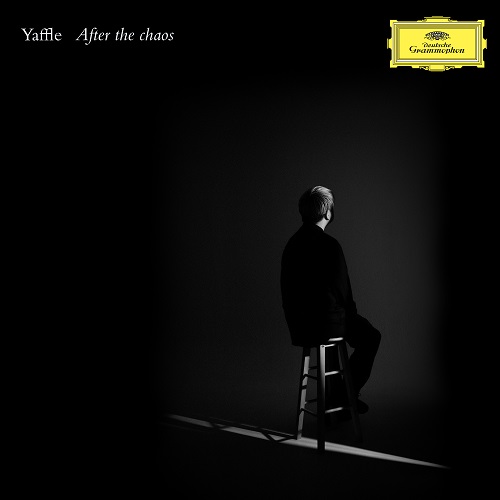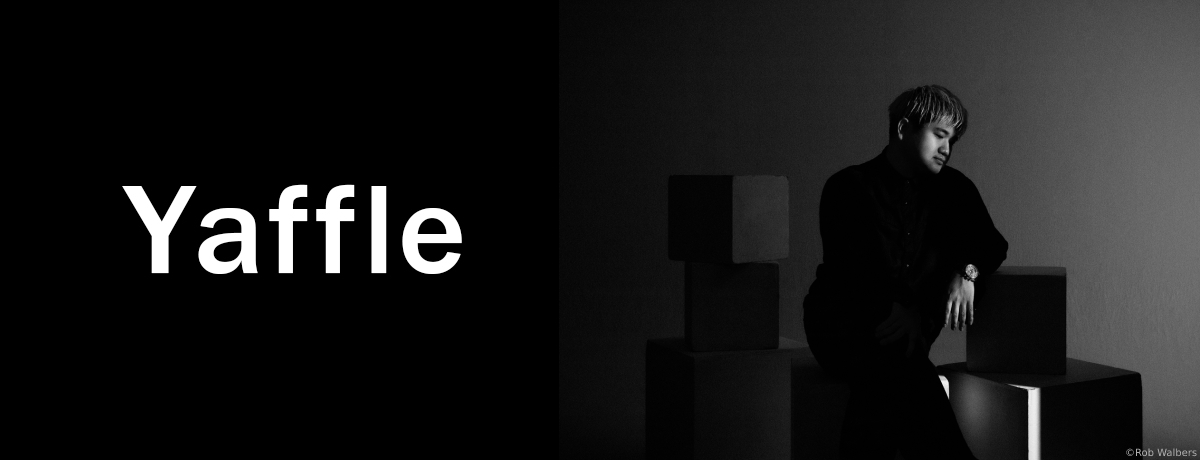『After the chaos』ライナーノーツ公開!

『After the chaos』にはYaffleの個人的なノスタルジアとともに、疫病や戦争に覆われた混沌(カオス)の世界へのメッセージも秘められている。私小説的なアルバムが時代の張り詰めた空気に満たされていく。葛藤を内包する人間の美しさ。荒廃し、分断された世界でも続けられる人々の営み。音楽のなかに現れる人物は、作曲家自身であり、聴き手ひとりひとりでもある。
2022年夏、このアルバムの制作のために白夜のアイスランドへと渡ったYaffleは、レイキャビクのスタジオで現地のアーティストたちとコラボレーションしながら楽曲を作り上げていった。作品の一部は日本に持ち帰り、石上真由子やコハーン・イシュトヴァーンなど、クラシック音楽のフィールドで活躍する同世代の演奏家を迎えてレコーディングを行なった。
『After the chaos』がクラシック音楽のアルバムなのか、それともポップスのアルバムなのかと考えることはあまり意味がない。それどころか、カテゴライズを静かに拒むこのアルバムを従来のジャンルに当てはめようとすれば、作曲家の姿はたちまちアイスランドの霧のなかに消えてしまうだろう。
Yaffleは幼少期からピアノに親しみ、高校の吹奏楽部でファゴットを演奏した経験を持つ。高校卒業後は国立音楽大学に進学し、前衛音楽の作曲を川島素晴に学んだ。大学在学中にはジャズ、とりわけビッグバンドにも熱心に取り組んでいる。高校時代からクラシック音楽を愛聴するようになったYaffleは、エルガーやヴォーン・ウィリアムズ、フォーレ、ラヴェルといったイギリスとフランスの作曲家に傾倒し、同時にシガー・ロスやレディオヘッドをはじめとする洋楽にものめり込んでいった。『After the chaos』に収められた10曲には、Yaffleのそうした音楽家としてのこれまでの歩みが映し出されている。
レイキャビクでの制作に同行した私にYaffleが話してくれた、『After the chaos』を聴くためのヒントをここに書き記していこう。
アルバムはRAKELとのコライト作品《Stay in the light》で幕を開ける。RAKELはIcelandic Music Awards 2021の新人賞にノミネートされるなど、アイスランドで今最も注目される若手ミュージシャンのひとりだ。この作品はアルバム全体のプロローグにあたるもので、夜明けへの希望を歌うヴォーカルと、そのほかのセクションの不穏なテクスチャとの相反が強く印象に残る。歪さを抱え、矛盾し、逆行する人間性をYaffleは肯定する。そうした葛藤を内包する人間の美しさが、このアルバムを貫くひとつのテーマとなる。
《as a human》でいよいよ本編に入り、カオスが訪れたあとの物語が始まる。荒廃し、繋がりを失った世界。圧倒的無力感のなかで、それでもなんとかやっていこうともがく人々。それは新型コロナウイルスとロシアによるウクライナ侵攻に直面した2020年代の世界と、そこに生きる私たちにリンクする。この曲は、アイスランドへ出発する前に、東京のスタジオでギタリストの西田修大とともに作られた。ローズ・ピアノやウーリッツァー、ハモンドオルガン、チェレスタなどを用いて音の素材を集め、ピアノとギターで即興的にレコーディングしたものをベースに楽曲を構築していった。
アイスランドのシンガーソングライター、CeaseToneとのコラボレーションである《Alone》は、レイキャビクで最初に書かれた作品。タイトルの通り、孤独と喪失の音楽である。Yaffleは哀しみの昇華よりも、喪失を悲しむことそのものに意味を見出す。リフレインで歌われる「これほど孤独だとは思ってもみなかった」という現実が、振り子のように一定の間隔で心に襲いかかってくる。
レイキャビクのスタジオでSIGGI STRING QUARTETを招いてレコーディングされた 《From Me To You》。そのタイトルは、スティングとギル・エヴァンスがカヴァーしたジミ・ヘンドリックスの《Little Wing》(1987年のウンブリア・ジャズ・フェスティバルのライヴ)からとられている。スティングが曲のクライマックスで繰り返し歌う「From me to you」というフレーズがYaffleの心を捉えた。分断された世界で、遠いところにいる人へ手紙を書く。届くかもわからない。返事が来るかもわからない。それでも手紙を書くことがYaffleにとっては大切なことなのだ。ここではノイズが重要な役割を担っている。
アイスランドの嵐をイメージして書かれた《Storm》では、「いつかもとに戻れるはず」という希望と、「もう二度ともとには戻れない」という悲観的予測が交錯している。この作品は、個人的な動機で作り出されたものが、次第に社会的な事象にも結びついていくというコンセプトに基づいている。アイスランドのシンガー、KARÍTASによって歌われる分断は、一組の人間の分断であり、より大きな世界の分断でもある。
レイキャビクからヨークルスアゥルロゥンへと向かう道中に得たインスピレーションによって生み出されたのが《Brown rain》だ。破壊された世界にかろうじて残された道を1台の車が走っている。そこに泥水のような雨が降っている。「移動は別離と出会いを伴う行為。だから移動することは尊いこと」とYaffleは語った。この作品はミニマル・ミュージックの巨人、フィリップ・グラスへのオマージュでもある。定点にピンを置いているからこそ、近づいても離れても距離がわかる。ミニマル・ミュージックの反復にYaffleは座標のイメージを重ねている。
《Mercy through the Clouds》はヴァイオリニスト、石上真由子のために書かれた作品で、石上のヴァイオリンの濃密な音色を引き立たせるストレートな旋律美が特徴だ。また自身の原点でもあるファゴットのフレーズには、作曲家のノスタルジアも見出せるだろう。美しいものを汚していくことによってその美しさをより際立たせるというYaffleのスタイルは、クラシカルなメロディがノイズによって覆われ、輪郭が曖昧なものとなっていくこの作品にとりわけ顕著に表れている。
オランダのシンガーソングライター、Benny Singsとともに作り上げた《Empty Room》は、Yaffleのアーティスト・プロジェクトの第1弾として2018年にリリースされた作品。Yaffleは、自身の転機となった楽曲を『After the chaos』のためにアコースティックな楽器を用いて再構築した。今回のリワークでは、編成を決めてから曲を書くという古典的な手法に敬意を表し、その制約のなかでどんな新しいことができるのかをテーマに定めた。
《You don’t have to feel more pain》も《as a human》と同じく、東京のスタジオで西田と即興的にレコーディングを行い、レイキャビクで仕上げられた。ブロック型の構成を持たないこの作品は、前の2曲と形式的なコントラストを生み出している。明るさのなかに暗さを含んだその色彩は、アイスランドの白夜を思い起こさせる。西田のギターの硬質でクリアなサウンドのなかで、コハーン・イシュトヴァーンのクラリネットの柔らかな音色が聴こえてくると、絶望に覆われたアルバムにも一筋の光が差し込む。
アルバムの最後には再び《Stay in the light》が置かれる。フォーク・ミュージックのスタイルはYaffleのワークスでは珍しい。ここにはもはや葛藤はなく、音楽はテキストにふさわしい本来の姿を取り戻している。Yaffleはこの作品を通して、世界が分断され、荒廃しようとも続けられる人間の営みを描き出した。それでも生きていくしかない。それでも生き続けていく。そうした人間の強さに希望を託して、アルバムは幕を閉じる。
2023年1月 八木宏之
“After the chaos” conceals not only Yaffle’s sense of nostalgia but also a message for the world of chaos ridden with epidemics and war. Almost a personal essay of Yaffle, the album is filled with the taut air of our times. The beauty of human beings contains struggles. People continue to live even in the most devastated and divided world. The protagonists of his music are the composer himself, at the same time, every one of the listeners listening.
Summer of 2022, Yaffle began work on this album in the land of the midnight sun, collaborating with local artists in a studio in Reykjavik, Iceland. Part of the tracks produced there was then brought back to Tokyo and recorded with a fellow generation of artists who play an active role in today’s classical music, including Mayuko Ishigami and István Kohán.
It hardly makes sense to ask whether “After the chaos” is a classical or pop album. Instead, the album quietly defies categorization, and any attempt to fit it into conventional genres would quickly make the composer disappear into the mist of Iceland.
Yaffle has played piano since childhood and bassoon in his high school brass band. After graduating high school, he went to the Kunitachi College of Music and studied avant-garde music composition under Motoharu Kawashima. At university, he was a devotee of jazz, especially big-band jazz music. His love of classical music began in high school when he became an avid fan of English and French composers such as Elgar, Vaughan Williams, Faure, and Ravel, as well as listening to more pop acts like Sigur Rós and Radiohead. All ten pieces on “After the chaos” reflect Yaffle’s journey as a musician to date.
Here are some tips for listening to “After the chaos” that Yaffle shared with me as I accompanied him to Reykjavik for its production.
The album opens with “Stay in the light,” which he co-wrote with RAKEL, one of the emerging Icelandic musicians, a nominee for Best New Artist at the Icelandic Music Awards 2021. The song is the prologue to the album, and the vocals, which sing of hope for the dawn, contradict the disconcerting textures of the other sections of the album. Yaffle affirms that humanity is distorted, inconsistent, and retrogressive in nature, and such conflicts encompassed in the beauty of humans are the theme throughout the album.
With “as a human,” the album begins the story of what happens after chaos strikes. The world has been desolated and lost its connection. People struggle to get by amidst an overwhelming sense of helplessness. It directly links to the world of the 2020s, where people live in the face of the spread of COVID-19 and Russia’s invasion of Ukraine. Yaffle composed this piece with guitarist Shuta Nishida in a studio in Tokyo before leaving for Iceland. Gathering sound materials on Rhodes Piano, Wurlitzer, Hammond organ, celesta, and more, music was written over improvised recordings of piano and guitar.
The first song written in Reykjavik was “Alone,” a collaboration with Icelandic singer-songwriter CeaseTone. As the title suggests, it is a music of loneliness and loss, and Yaffle finds meaning in the grieving itself of loss rather than in the sublimation of sorrow. The refrain, “Never thought I could be ever so alone,” tags at the listener’s heartstrings at regular intervals, like a pendulum.
“From Me To You” was recorded in a Reykjavik studio inviting Siggi String Quartet. The title is taken from Sting and Gil Evans’ cover of Jimi Hendrix’s “Little Wing” (performed live at the 1987 Umbria Jazz Festival). The phrase “From me to you,” which Sting repeatedly sings at the song’s climax, captivated Yaffle. In a world divided, the person writes a letter to someone far away, not knowing if it will even reach them. You may or may not receive a reply. Still, it was important for Yaffle to write a letter. Noise plays an important role here.
In “Storm,” which uses the imagery of an Icelandic storm, a sense of hope that “things will return to normal one day” intersect with a pessimistic prediction that “things will never return to normal again.” It’s a song based on the concept that what is created for personal motives gradually finds its way into social events. The theme of “division” sung by Icelandic singer KARÍTAS is the same division between a set of people and that of the larger world.
“Brown rain” was inspired by the travel heading from Reykjavik to Jökulsárlón. A car goes on the road that’s barely left in a destroyed world. Muddy rain is falling. “Traveling is an act of departure and encounter. That’s why it’s precious,” says Yaffle. This piece is also a tribute to the minimal music giant Philip Glass. When your pins are placed at fixed points, you can tell the distance, whether you are moving closer or away. Yaffle juxtaposes the image of coordinates with the repetition of minimal music.
“Mercy through the Clouds,” written for violinist Mayuko Ishigami features a simple melodic aesthetic that complements the deep, rich tone of Ishigami’s violin. You may sense the composer’s nostalgia in the phrases of the bassoon, an instrument that is his point of origin. Yaffle’s style of taking a beautiful thing and making it more attractive by defacing it is undeniable in this piece. The classical melody is obscured by noise, and its contours become blurred.
“Empty Room,” co-written with Dutch singer-songwriter Benny Sings, is the first of Yaffle’s artist projects released in 2018. The composer revisits this pivotal song and gives a new acoustic treatment for “After the chaos.” In reworking the piece, Yaffle paid homage to the classic writing method of deciding on its arrangement first and set out to see what new ways he could find within the constraints of that method.
Like “as a human,” “You don’t have to feel more pain” was improvised and recorded with Nishida in a studio in Tokyo and finished in Reykjavik. This piece does not have a block-type of structure, creating a formal contrast with the preceding two compositions. Its palette of brightness with a hint of darkness evokes the midnight sun of Iceland. When István Kohán’s soft clarinet tone is heard amidst the solid and clear guitar sound of Nishida, it is one ray of light that shines through the album; otherwise, overshadowed by despair.
“Stay in the light” bookends the album. The folky style may be rare in Yaffle’s work, but here there is no longer any conflict; the music has taken its deserved place with the text. Through this piece, Yaffle depicts a human endeavor that will continue even as the world is divided and devastated. Still, we have to live. We have to live on. The album closes, leaving hope in the strength of human beings.
January 2023
Hiroyuki Yagi
(English translation by Kyoko Maruyama)

